Brewing Beer with Maris Otter Malt
Published: August 11, 2025 at 5:17:51 AM UTC
Last updated: December 12, 2025 at 3:24:55 PM UTC
Maris Otter malt is a premium British 2-row barley, celebrated for its rich, nutty, and biscuity taste. It's a favorite among brewers for crafting high-quality beers. This malt variety hails from the UK and has become a cornerstone in British brewing. It adds to the characteristic flavors of many premium beers. Its unique taste enhances the brewing experience, enabling brewers to create complex and nuanced beers.
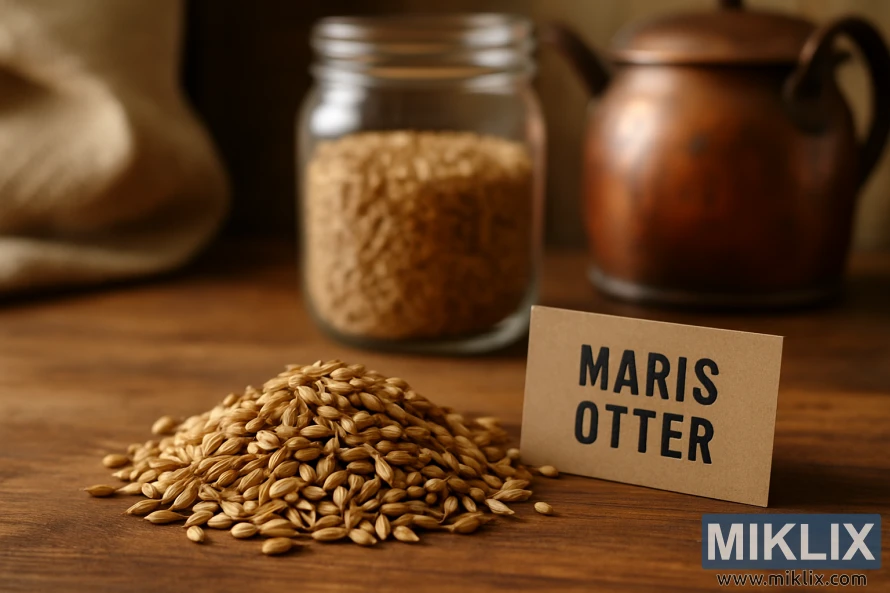
Key Takeaways
- Crafting beer with Maris Otter malt results in rich, nutty, and biscuity flavors.
- This British 2-row malt is a premium choice for brewers seeking high-quality ingredients.
- Maris Otter malt is a staple in British brewing traditions.
- Using Maris Otter malt allows for the creation of complex and nuanced beer profiles.
- Premium beers brewed with Maris Otter malt are highly regarded for their depth of flavor.
Understanding Maris Otter Malt's Heritage
Dr. GDH Bell's team at the Plant Breeding Institute in Cambridge pioneered Maris Otter malt in 1965. This British 2-row malt has become a cornerstone of traditional brewing in the UK.
Maris Otter malt's history is deeply intertwined with British brewing heritage. Bred for its rich, nutty, and biscuity flavor, it quickly became popular among brewers. They sought it for crafting high-quality ales and lagers.
The significance of Maris Otter malt goes beyond its flavor. It represents a connection to historical brewing practices. Its development and continued use highlight the importance of heritage and tradition in brewing.
Today, Maris Otter malt is a sought-after ingredient among craft brewers worldwide. It's valued not just for its unique characteristics but also for its historical significance. It continues to play a vital role in creating authentic British-style beers.
The Unique Properties of Maris Otter Malt
Brewers often choose Maris Otter malt for its low nitrogen content and other beneficial properties. These enhance beer quality. Known for its distinct characteristics, Maris Otter malt is a staple in many breweries. Its low nitrogen content makes it perfect for brewing cask-conditioned ales.
The low nitrogen content in Maris Otter malt leads to a better flavor balance in the beer. This is due to a more favorable protein-to-sugar ratio. Its rich, nutty, and biscuity flavor profile makes it ideal for creating complex, high-quality beers.
Maris Otter malt is known for its ability to produce a rich, full-bodied beer with a smooth texture. Its versatility in brewing makes it suitable for various beer styles. This is true for those requiring a traditional or authentic flavor profile.
- Low nitrogen content
- Rich, nutty flavor profile
- Smooth texture
In summary, Maris Otter malt's unique characteristics and brewing properties make it a favorite among brewers. They seek to craft high-quality, flavorful beers.
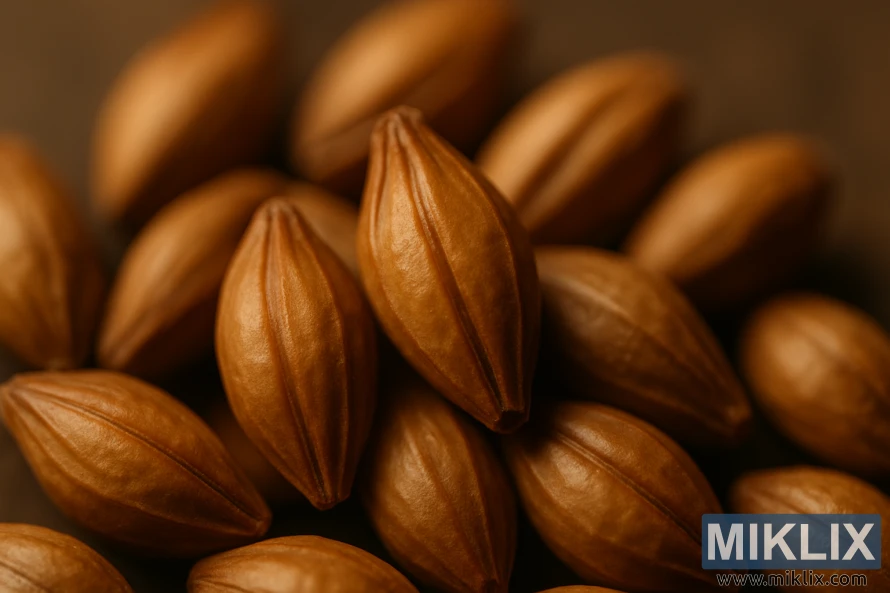
Chemical Composition and Characteristics
For brewers aiming to craft high-quality beers, understanding Maris Otter malt's chemical makeup is key. It boasts a Lovibond rating of 2.0-4.5 °L, which reflects its color and its effect on the beer's appearance.
The nutritional profile of Maris Otter malt is marked by its nitrogen level, which falls between 9-10%. This nitrogen content is vital. It affects the malt's enzymatic activity and, by extension, the fermentation process.
Its extract content stands at approximately 81.5%. This high value means Maris Otter malt significantly contributes to the beer's gravity and body. It's a prized ingredient in brewing for this reason.
Maris Otter malt's unique blend of chemical characteristics makes it a versatile and valuable brewing ingredient. It supports the creation of a broad spectrum of beer styles. This includes traditional ales and more complex, modern brews.
Flavor Profile and Aromatics
Maris Otter malt stands out for its unique flavor and aromatics, making it perfect for a wide range of beers. It boasts a rich, nutty, and biscuity taste, adding depth to any brew. This characteristic is key to the beer's overall character.
The malt's complex chemical makeup is behind its rich flavor. The malting process, where barley is germinated and dried, enhances its natural sweetness and depth. This process is what brings out the malt's distinct flavor notes.
The aroma of Maris Otter malt is equally captivating, with brewers noting a sweet, malty scent. This aroma is a result of the malt's specific chemical makeup and how it interacts with other brewing ingredients. It's a testament to the malt's unique properties.
- The flavor profile of Maris Otter malt includes rich, nutty, and biscuity notes.
- The malt's aromatics contribute to a sweet, malty aroma in the finished beer.
- The complex chemical composition of Maris Otter malt is responsible for its distinct flavor and aroma.
In conclusion, Maris Otter malt's flavor and aroma are essential for brewing top-notch beers. Its rich, complex taste and sweet, malty scent make it a favorite among brewers. It's ideal for traditional British ales and other styles that benefit from its unique qualities.
Comparing Maris Otter to Other Base Malts
Maris Otter malt is a standout among 2-row malts, but how does it stack up against Golden Promise and Halcyon in brewing? It's vital for brewers to grasp the differences between these malts. This knowledge is key to crafting beers with precise flavor profiles and characteristics.
Maris Otter, Golden Promise, and Halcyon are all top-tier 2-row malts, each with unique traits. These traits influence their suitability for various brewing tasks. Here's a breakdown of their key characteristics:
- Maris Otter: Renowned for its rich, nutty, and biscuity taste, Maris Otter is a favorite for traditional British ales.
- Golden Promise: Boasts a sweeter and more robust flavor than Maris Otter, making it perfect for Scottish ales and certain whiskey productions.
- Halcyon: Offers a cleaner, more delicate taste, ideal for brewing lighter beer styles or for those seeking a simpler malt profile.
In choosing between these malts, brewers must consider their beer's desired flavor and brewing techniques. For example, Maris Otter's complex taste is ideal for beers needing depth, like bitters and pale ales.
The decision between Maris Otter and other 2-row malts hinges on the brewer's objectives and preferences. By understanding each malt's unique characteristics, brewers can make choices that elevate their beer's quality and consistency.
Best Beer Styles for Maris Otter Malt
Maris Otter malt's rich, nutty flavor makes it perfect for several traditional beer styles. Its versatility allows brewers to create a range of ales that highlight the malt's complex traits.
It's a top pick for cask-conditioned ales, where its full flavor can shine. It's also favored for English mild and brown ales, adding depth and complexity. Plus, Maris Otter malt brings a subtle nuttiness to pale ales, enriching their flavor.
- Cask-conditioned ales
- English mild ales
- English brown ales
- Pale ales
- Porter and stout (for added depth)
Brewers using Maris Otter malt can expect a full-bodied flavor with notes of nuttiness and biscuit. This makes it a great choice for traditional English-style ales with a rich heritage.
By using Maris Otter malt in their recipes, brewers can make beers that are not just flavorful but also deeply rooted in tradition. Whether brewing a cask-conditioned ale or an English brown ale, Maris Otter malt ensures rich, complex flavors.
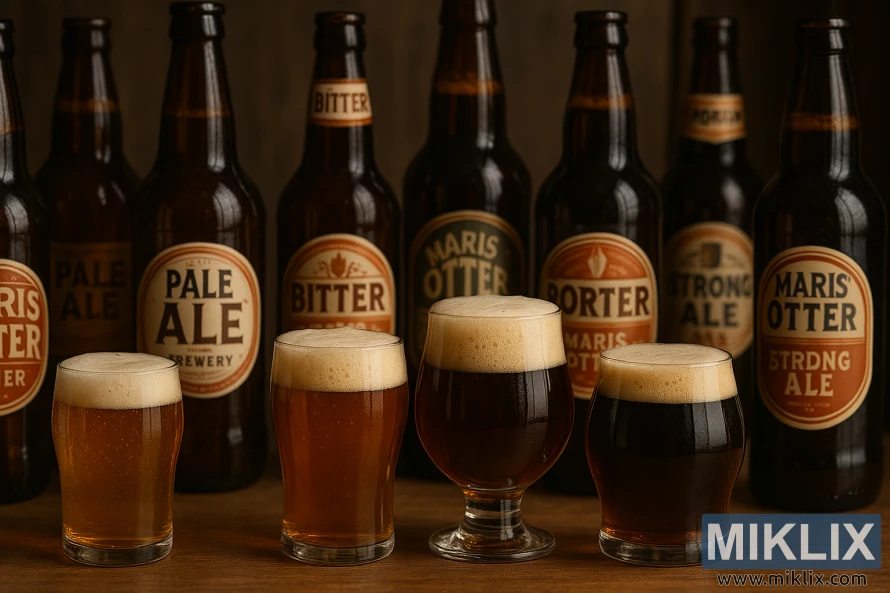
Mashing Techniques and Temperature Control
Maris Otter malt is renowned for its rich, complex flavor. It requires careful attention to mashing techniques and temperature control. Brewers face a significant challenge with its rapid hydration, leading to a thick, hard-to-mix mash.
To overcome this, several strategies can be employed. Adjusting the water-to-grist ratio helps achieve a more manageable mash consistency. Using a step mashing technique also aids in extracting the desired flavors and fermentables. This method involves gradually increasing the mash temperature to activate different enzymes.
Temperature control is critical when brewing with Maris Otter malt. The ideal mashing temperature varies based on the brewer's goals. Whether aiming for a beer with a rich, malty flavor or a drier, more attenuated character, a temperature range of 152°F to 155°F is generally considered optimal for a balanced flavor.
Some key considerations for temperature control include:
- Monitoring the mash temperature closely to avoid overheating, which can lead to the extraction of unwanted flavors.
- Using a thermometer to ensure accuracy and consistency in temperature control.
- Adjusting the mash temperature as needed based on the specific characteristics of the Maris Otter malt being used.
By optimizing mashing techniques and temperature control, brewers can unlock the full flavor of Maris Otter malt. This results in high-quality beers that showcase its unique characteristics.
Recipe Formulation Guidelines
Maris Otter malt is a versatile ingredient, suitable for many beer styles. Its full flavor can be unlocked with the right recipe guidelines. Understanding its unique characteristics and how it interacts with other ingredients is key.
To brew balanced and flavorful beers, follow a few essential guidelines. Maris Otter malt is known for its rich, nutty, and biscuity flavors. It can serve as a base malt in various beer styles, from pale ales to barley wines.
- Use Maris Otter as a base malt for a rich, complex flavor profile.
- Balance its nutty flavor with other ingredients, such as hops and specialty malts.
- Experiment with different brewing techniques, like mashing temperatures and hop additions, to fully utilize Maris Otter malt.
By adhering to these guidelines and grasping Maris Otter malt's unique traits, brewers can craft a wide array of delicious beers. These beers will highlight the malt's versatility.
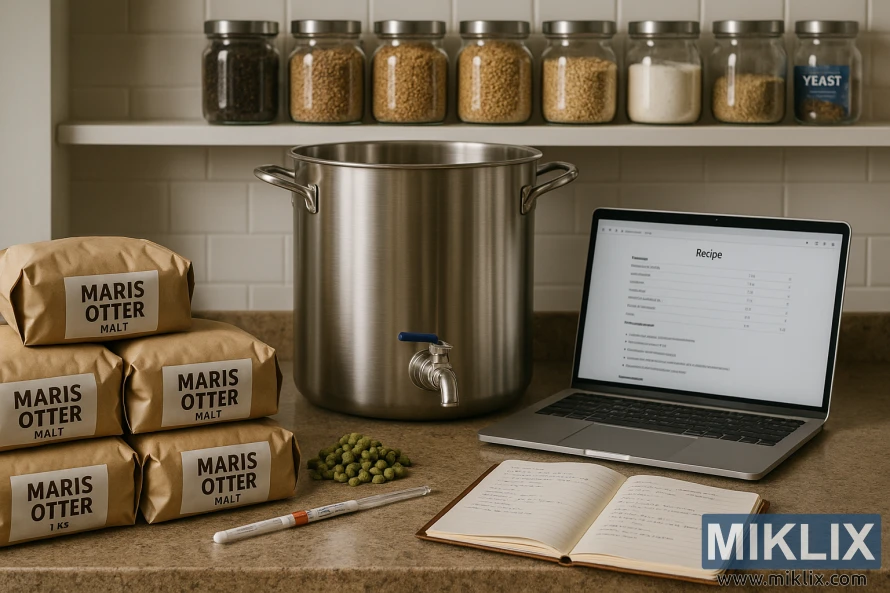
Common Brewing Challenges and Solutions
To fully appreciate Maris Otter malt, brewers must be aware of common pitfalls and solutions. Brewing with Maris Otter malt can lead to slow run-off and stuck mashes. These issues can greatly affect the brewing process.
One major concern with Maris Otter malt is its tendency to cause slow run-off. This is due to its high protein content and interaction with brewing water. To address this, brewers can take several steps:
- Adjust the mash temperature to optimize enzyme activity and improve lautering.
- Use a step-mashing technique to help break down complex proteins and starches.
- Monitor the pH levels to ensure they are within the optimal range for lautering.
Another common challenge with Maris Otter malt is the risk of stuck mashes. This happens when the mash becomes too compact, hindering wort flow. To prevent this, brewers can:
- Use a sufficient amount of brewing water to maintain a healthy mash-to-water ratio.
- Regularly stir the mash to prevent compaction and ensure even extraction.
- Monitor the mash temperature to prevent overheating, which can cause the mash to become stuck.
By understanding these common brewing challenges and implementing the right solutions, brewers can minimize problems. This ensures the creation of high-quality beers using Maris Otter malt. Effective troubleshooting and process adjustments significantly improve the final product's quality and consistency.
Storage and Handling Best Practices
To preserve the distinct characteristics of Maris Otter malt, brewers must adhere to best practices in storage and handling. Maris Otter malt should be stored in a cool, dry place to maintain its quality and freshness.
Proper storage conditions are essential to prevent degradation of the malt. Here are some guidelines to follow:
- Store Maris Otter malt in airtight containers to protect it from moisture and pests.
- Keep the storage area cool, with a consistent temperature below 70°F (21°C).
- Maintain low humidity levels in the storage area to prevent moisture absorption.
- Rotate stock regularly to ensure that older batches are used before they degrade.
Handling Maris Otter malt carefully is also critical. Avoid exposing the malt to direct sunlight or moisture, as this can cause a loss of flavor and aroma. By following these best practices, brewers can ensure that their Maris Otter malt remains in optimal condition. This is ready for use in brewing a variety of beer styles.
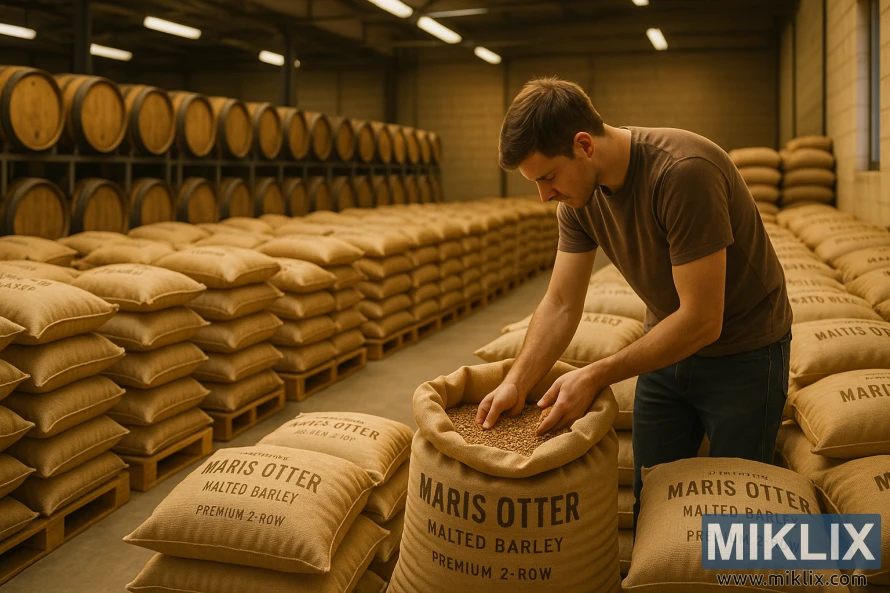
Commercial Brewing Applications
Maris Otter malt's versatility makes it a top choice for commercial beer recipes. Known for its rich, nutty, and biscuity flavor, it's a favorite among many breweries. This British 2-row malt stands out for its unique taste.
Woodforde's Brewery and Thornbridge Brewery are among those who use Maris Otter malt. Its unique properties make it suitable for a wide range of beer styles. From traditional ales to modern brews, it's a versatile ingredient.
Maris Otter malt's uses in commercial brewing are varied. It can serve as a base malt, creating a foundation for different beer styles. Or, it can be used as a specialty malt, adding depth and complexity to specific brews.
Using Maris Otter malt offers several benefits. It enhances flavor with its rich, full-bodied taste. It also pairs well with various hop profiles. Plus, its high yield and ease of use make it ideal for large-scale brewing.
- Enhances flavor profile with nutty and biscuity notes
- Compatible with various hop profiles
- High yield and ease of use for large-scale brewing
Understanding how commercial breweries use Maris Otter malt can help brewers. It offers insights into its versatility, improving their own brewing practices.
Quality Assessment and Selection
Evaluating Maris Otter malt is key to achieving consistency and quality in brewing. The quality of Maris Otter malt greatly impacts the beer's flavor and character.
To assess Maris Otter malt quality, brewers should focus on appearance, aroma, and brewing performance. Here are some tips for evaluating Maris Otter malt:
- Check the malt's appearance for consistency in color and texture.
- Assess the aroma to ensure it has a rich, nutty, and biscuity scent.
- Evaluate the malt's brewing performance by monitoring the fermentation process and final beer quality.
When selecting Maris Otter malt, brewers should look for malt that is fresh, has consistent quality, and is sourced from reputable suppliers.
High-quality Maris Otter malt should have certain characteristics. These include:
- Moisture content: Typically should be around 4-5%.
- Extract content: Should be high to ensure efficient brewing.
- Diastatic power: Important for starch conversion during mashing.
By carefully assessing and selecting Maris Otter malt, brewers can ensure they use the best ingredients. This leads to improved flavor and quality in their beers.
Sustainability and Future of Maris Otter Production
Maris Otter malt, celebrated for its rich flavor, holds a promising future in brewing. Its production is set to continue, backed by breweries and maltsters dedicated to its legacy. This dedication is vital for Maris Otter's sustainability, ensuring traditional methods and high-quality standards are upheld.
The future of Maris Otter production is inextricably linked to the brewing industry's quest for premium, traditional ingredients. As craft breweries expand, the demand for Maris Otter malt is expected to stay robust. Commercial brewing's use of Maris Otter malt will also persist, driven by consumer preference for premium beers.
Several elements contribute to Maris Otter's sustainable production. These include sustainable farming, efficient malting, and a commitment to preserving the Maris Otter variety's genetic integrity. By embracing these practices, maltsters can reduce environmental impact while preserving the malt's unique traits.
The advantages of sustainable Maris Otter production are manifold. They include:
- Reduced environmental impact through efficient water and energy use
- Preservation of traditional farming practices and genetic heritage
- Support for local agriculture and economies
- Consistent high-quality malt for brewers
As the brewing industry evolves, Maris Otter's future hinges on maltsters and brewers adapting while preserving its quality and heritage. With its distinctive flavor and rich history, Maris Otter malt is poised to remain a cornerstone in brewing for years ahead.
Conclusion
Maris Otter malt is a premium British 2-row barley, celebrated for its rich, nutty, and biscuity flavor. It's a favorite among brewers for its distinct taste.
Understanding Maris Otter malt's heritage, properties, and brewing applications is key to unlocking its full flavor. This malt offers a unique flavor profile and aroma, perfect for a wide range of beer styles.
Using Maris Otter malt in brewing can lead to complex and balanced flavors. It's an excellent choice for craft brewers. As demand for high-quality malts grows, Maris Otter's future looks bright. Many breweries are adopting sustainable practices to ensure its availability.
In summary, Maris Otter malt is a versatile and valuable ingredient for brewers. It offers a rich flavor profile and numerous brewing applications. By incorporating Maris Otter malt into their recipes, brewers can create a variety of delicious beers. This showcases its unique characteristics, highlighting its value in the brewing industry.
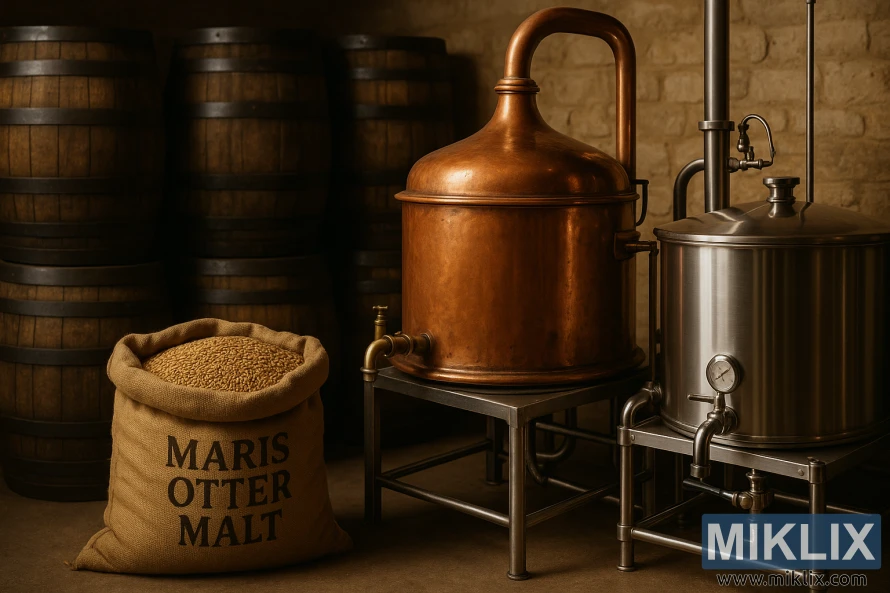
Further Reading
If you enjoyed this post, you may also like these suggestions:
